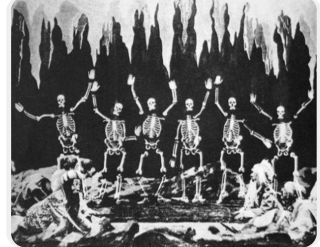Media
Dreams on Screens
Georges Meliès was a pioneer of the magic machine of cinema.
Updated October 6, 2023 Reviewed by Ray Parker
Key points
- Cameras and projection machines made possible a smooth transition between dreams and illusion.
- Just after Sigmund Freud's "Interpretation of Dreams," Paris filmmakers engaged in the creation of dreams.
- Both cinema and dreams are ways of exploring our inner worlds and our unconscious desires.

Around the turn of the 20th century, a magician was inspired to dedicate his mind to the new technology of moving pictures. Georges Meliés (1861-1938) instantly picked up on how cameras and projection machines made possible a smooth transition between dreams and illusion through entertainment on a screen.
Impossible Fiction

The impossible became possible with the development of filmic techniques. Meliès’s initial forays were short, unique vignettes that required, and displayed, frequent disruptions in space and time.
For curious audiences, moving pictures were a marvel, a strange fruit of modernity. They offered incredible rapid journeys out of the here and now. Exotic locales, strange beings, and mysterious happenings were the focus of many early films as Meliès knew that his audience wanted to be transported.
It is not surprising that he pursued a career in film since his previous profession was as a magician and impresario at the Robert Houdin Theater. Magic was at the core of his films, and I would like to argue that it is magic that connects the silver screen and the dream world.
Indeed, our dreamworlds are magical; images come to us as theatrical performances of our fantasies. We are neither the projectionists nor the directors of these episodes in which all sorts of strange things occur.
But what if we were able to create dreamworlds? That is precisely what Meliès and the Lumière brothers discovered during the development of the filmic technology that Thomas Edison invented.
The French avant-garde used technology that captured time and space to make a cinematograph. They experimented with cameras, light, film, and every other aspect, which the brand-new medium put into such delicious play.
The Dream Machine
Films tell us about life, but in terms of grand, neat, and above all, constructed. Dreams tell us about life messily, they are histrionic and unwieldy. But they are spectacles, like film and theater.
Similarly, we find many instances of metamorphosis and wonder in cinema that seduce us into letting go of our agency and surrendering to the spectacle.
The impossible occurrences and grand gestures that populate films exemplify and amplify the mystery of life. One reason is that films, such as Meliès’s The One-man Band (1900), visualize a sense of unchained play. The play of the senses that film technologies enabled became a play on the sense of presence itself when projected onto blank screens.
Ultimately, there is a magic border, a fuzzy belt of light, between the prosaic and the miraculous. And nothing makes that more apparent than cinema.
Histoire du Cinéma
Has every human being stared at the moon and dreamed of going there? Antoine de Saint-Exupéry’s Le Petit Prince (1943) and Italo Calvino’s Cosmicomics (1965) describe such journeys, but it is Meliès Journey to the Moon (1902) that brings us the magic, mystery, and wonder of the enterprise to fantastic life.
Just after Sigmund Freud (1856-1939) published his Interpretation of Dreams (1899), filmmakers in Paris were engaged in the creation of dreams. The dream construction process Freud described and the creative act has similarities, which he highlighted in Creative Writers and Daydreaming (1908). For example, condensation in which multiple strands are integrated into highly salient symbols. This can range from types, like the scary clown, to settings and color schemes.
The studio system became the many-pronged dream machine, which would serve as the perfect adjunct to modernity. Simultaneously, a simulacrum, a simulation, and a repetition, there were few mediums better attuned to the confusion and reflexivity that came to exemplify the 20th century.
Modernity is an era concerned with newness, the development of power through technology, and of course, human hubris. This century of cinema was the space for great acts of artistic creation, which inspired, frightened, and entertained us immensely.
Screens
Now, 125 years later, we find that as much as the size of the image and its influence upon our minds has grown, the screen itself has shrunk. From larger-than-life, Technicolor and 3D to tiny tablets that fit in your pocket. We have arrived at a place where we are constantly surrounded by moving pictures.
Alas, they chase us all day. From Facetime to Times Square, from education to leisure, our eyes dart from box to box. From the magic of wonder to the dark arts of persuasion and forgery (i.e., advertisements), the dream machine enfolds our fantasies in its dense cloak. Imagination intensifies as technology develops and for some, waking life is an endless set of movies.
Like Narcissus, who stares at his reflection in the pond, is mesmerized, and jumps into the water and drowns. At some point, the magic was absorbed into the difficult process of storytelling through moving pictures. Fiction became rendered impossible as we began to watch the eternal performance of illusion played out by the machines that surround us.
As we got used to the medium and learned to listen to it, the magic onscreen was cleaved from the dream machine. Meliès and his precious dream world were forgotten as Hollywood became the center of filmmaking. But it was his intuition that this medium was perfect for capturing (and being in thrall to) magic tricks and dream imagery that formed the cornerstone for the aspirations of the industry.
References
Gabriel, R. (2023). A Suspicious Science: The Uses of Psychology. New York: Oxford University Press.




